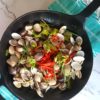My first memories of this omelette is the wayang (大戏) in the 1970s. I would carry my chair or a bench to share with my mum and sit below the stage to watch the opera singers sing. There were the Cantonese, Hokkien and Teochew versions that I watched with enthusiasm. Of the different dialect operas, I like the Cantonese ones the most.
During the eighth lunar month, it was a tradition to celebrate Por Tor. Since my parents were hawkers in the wet market, it was quite an elaborate affair for us for years. There would be celebrations and the committee would bulk order a whole batch of chicken from my dad to distribute to the members, of which my parents were. It is amazing to see how my father could carry 12 chicken on one shoulder and lower all of them into the braising liquid that he made.
Single-handedly, he would braise a dozen chickens at one go with his invention of this long pole on his shoulder. He would line his chickens and ducks on this long pole and cook them all at one go. All 100 over chickens and 100 ducks would be cooked in the morning by just one man. I cannot imagine how this is compared to the current kind of productivity we have. The pioneers were indeed a hardy lot and that’s why they could build a nation.
Over three days, there would be opera singers hired by the market committee members to perform for the community. Below the stage, hawkers sold oyster omelettes, char kway teow, ice-cream and Chinese prawn ngoh hiang. It was such a treat for kids.
Although I liked the Cantonese opera the most, they were seldom heard because they were expensive to hire. The teochew folks were good as well, and their story lines similar. But the Hokkiens ones sounded rough compared to the Teochews.
I think I was almost always the one kid who would sit through the opera singing till eleven. I liked them and learned how to watch them. However, through the years, the crowd dwindled. In the 1990s, while I was watching one of these, I remember there were less audience than the performers. I subsequently had children of my own and was too busy to spend time watching operas.
We don’t see them much anymore and I wonder if I can ever understand them now. Those were great days and every time I get to eat the oyster omelette, and if I am so lucky to chance upon those that sell the tiny cheap oysters we used to have instead of the large premium ones we get today, I will always remember those days under the stage. How I miss those days.

Oyster Omelette
Ingredients
- 4 eggs
- 6 Oysters or as many as you desire
- 1 Tbsp Garlic minced
- 2 Tbsp Oil
- A handful Coriander sprigs
- 2 Tbsp Fish or Light Soya Sauce
- 1 Tbsp Rice wine
Starch Mixture
- 2 Tbsp Tapioca Flour
- 1 Tbsp Rice Flour
- 150 ml Water
Chili Dip
- 3 tablespoons White vinegar
- 1/2 teaspoon Sugar
- A pinch Salt
- 7 cloves Garlic
- 3 birdseye chilies
Instructions
Make chili dip
- Put vinegar, sugar, salt, garlic and chilies together in a blender and blend until smooth.
Starch mixture
- Mix the flours with water to form a thin batter.
Cook
- Heat up a wok to high heat with a little oi, enough to coat pan onlyl.
- Add the starch mixture and wait till it is set, and beat in the eggs.
- Turn over and cook till brown.
- Add in more oil to crisp the omelette and batter.
- Break into pieces and create a hole in the middle for the remaining 1 Tbsp of oil, garlic and oysters.
- Sprinkle fish sauce and rice wine, season with salt and pepper and add a bit of chili dip.
- Finish off with coriander sprigs, and serve hot with chili dip.
In case you are really worried about the nutritional value of a plate of these. Here’s the analysis. 🙂

When eating Or Luak, must always listen to Chinese Operas. This is a Teochew one, that I can still understand quite a bit. When I was 10 years old, I even composed one. Just love it still, as much as I enjoy Phantom of the Opera and Les Miserables. Hehe… Enjoy!
I found this great The Meatman and they do wonderful food videos. There is some differences in the recipe though. I use garlic (essential), and they don’t, and they fry the paste brown from the start, while I brown mine at the end because I find it more efficient and taste better. So, I guess you will have to trial and error and see which works for you. Until I do good videos, theirs will do perfect.







